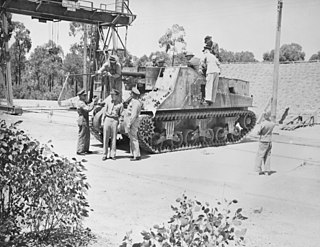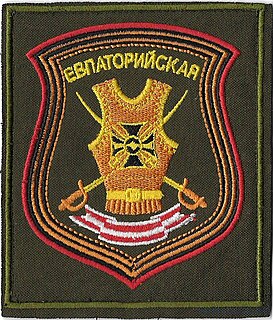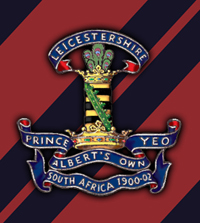 W
WThe 1st Armoured Brigade was a formation of the Australian Army during World War II. The brigade was formed in July 1941, at Greta, New South Wales from volunteers for the Second Australian Imperial Force and was assigned to the 1st Armoured Division. Raised initially for service in the Middle East, following Japan's entry into the war, the brigade was assigned to the defence of Australia in case of an invasion. After garrison duties in New South Wales and Western Australia, it was disbanded in November 1944 without seeing active service, although some of its former units saw action later with other formations.
 W
WThe 2nd Armoured Brigade was a formation of the Australian Army during World War II. The brigade was formed in July 1941, at Puckapunyal, Victoria, from Second Australian Imperial Force volunteers. It was assigned to the 1st Armoured Division in July 1941, with the intention of deploying it to the Middle East. However, it was reassigned to home defence following Japan's entry into the war, and was then transferred to the 3rd Armoured Division in October 1942. The brigade remained in Australia, undertaking defensive duties in Victoria and Queensland before being disbanded in January 1944. While it did not see any active service as a formation, some of its constituent units eventually took part in the campaigns on Tarakan, Labuan, Bougainville and around Aitape–Wewak in 1944–1945 after transferring to other brigades.
 W
WThe 19th Guards Mechanized Brigade is a formation of the Armed Forces of Belarus based in Zaslonovo (ru:Заслоново), a few kilometers east of Lepiel. The brigade traces its history back to the 1942 formation of the 2nd Guards Mechanized Corps of the Soviet Army during World War II. Subsequent designations during the Cold War included 2nd Guards Mechanized Division and 19th Guards Tank Division. Following the Cold War, the 19th Guards Tank Division was relocated to Belarus and became part of their armed forces in 1992. Thereafter, the unit was reduced to a personnel and equipment cadre unit and titled the 19th Guards Base for Storage of Weapons and Equipment before being upgraded to a mechanized brigade in 2008.
 W
WThe 3rd Operations Group is the operational flying component of the United States Air Force 3rd Wing. It is stationed at Joint Base Elmendorf–Richardson, Alaska, and is assigned to Pacific Air Forces' Eleventh Air Force.
 W
WThe 7th Mechanized Corps was a mechanized corps of the Red Army, formed three times. The corps was first formed in 1934 in the Leningrad Military District and was converted into the 10th Tank Corps in 1938. The corps was reformed in the summer of 1940 in the Moscow Military District and fought in the Battle of Smolensk, after which its headquarters became part of Group Yartsevo's headquarters. The corps was formed a third time in August and September 1943. The third formation fought in the Dnieper–Carpathian Offensive, Uman–Botoșani Offensive, Second Jassy–Kishinev Offensive, Battle of Debrecen, Budapest Offensive, Bratislava–Brno Offensive, Prague Offensive, and the Soviet invasion of Manchuria. Postwar, the corps' third formation became a division and was disbanded in 1957.
 W
WThe 8th Air Division is an inactive United States Air Force organization. Its last assignment was with Air Defense Command, being stationed at McClellan Air Force Base, California. It was inactivated on 1 July 1957.
 W
WThe 10th Armoured Division was an armoured formation of division-size of the British Army, raised during World War II and was active from 1941–1944 and after the war from 1956–1957. It was formed from the 1st Cavalry Division, a 1st Line Yeomanry unit of the Territorial Army (TA) which had previously been serving in Palestine. The division was converted from cavalry to armour and redesignated from 1 August 1941.
 W
WThe 30th Konstanty Ostrogski Mechanized Brigade is a formation of the Ukrainian Ground Forces. The full name of the unit is 30th Independent Mechanized Brigade "Konstanty Ostrogski".
 W
W15th Anti-Aircraft Brigade was an air defence formation of the Royal Artillery which saw service during the middle years of World War II. The brigade was formed in Gibraltar to control those AA units based there and disbanded shortly after the air threat had been diminished in 1944. The brigade was later reformed in 1947 as part of the post-war regular army, but disbanded in 1957 following the end of the AA era.
 W
WThe Training Center for Junior Specialists of the Kazakh Ground Forces named after Karasai Batyr is a Ground Forces formation of the Armed Forces of the Republic of Kazakhstan.
 W
WThe 21st Field Artillery Regiment is a field artillery regiment of the United States Army first formed in 1916. A parent regiment under the U.S. Army Regimental System, all components of the regiment are currently inactive. The regiment's last active element, 1st Battalion 21st Field Artillery Regiment, inactivated on 12 June 2014.
 W
WThe 22nd Field Regiment, Royal Australian Artillery was an artillery regiment of the Australian Army. Formed in 1916 as a howitzer brigade assigned to the 2nd Division, the unit served on the Western Front during World War I until it was disbanded in early 1917. In 1921, it was raised as a part-time unit in Victoria. It undertook defensive duties in Australia during World War II and in the late 1940s and into the mid-1950s the regiment served as a self propelled artillery unit assigned to the 2nd Armoured Brigade. It was disbanded in 1957.
 W
WThe 42nd Guards "Evpatoriyskaya Red Banner" Motor Rifle Division is a Russian military unit.
 W
WThe 10th Air Army was a unit of the Soviet Air Forces during World War II and the Cold War years.
 W
WThe 44th Kievskaya of the Red Banner Rifle Division of Nikolay Shchors, or 44th Kievskaya for short, was an elite military formation of the Soviet Union.
 W
WThe 48th Operations Group is the flying component of the 48th Fighter Wing, assigned to the United States Air Forces in Europe – Air Forces Africa. The group is stationed at RAF Lakenheath, England.
 W
WThe 56th Battalion was an infantry battalion of the Australian Army. It was originally raised in 1916 for service during the World War I and took part in the fighting in the trenches of the Western Front in France and Belgium before being amalgamated with the 54th Battalion in late 1918 following the German spring offensive reduced the numbers in both battalions. After the war, the battalion was re-raised as a part-time unit in New South Wales. During World War II the battalion was mobilised and undertook garrison duties in Australia until it was disbanded in 1944. It was briefly re-raised in 1956, but was disbanded the following year and its personnel used to re-raise the 4th Battalion, which later became part of the Royal New South Wales Regiment.
 W
WThe 279th Rifle Division was an infantry division of the Soviet Union's Red Army during World War II, formed twice.
 W
WThe 92nd Mechanized Brigade is a formation of the Ukrainian Ground Forces. The full name of the Brigade is the 92nd Separate Mechanized Brigade named after Ivan Sirko. The unit was formed in 1999 as the 6th Mechanized Division based on the 6th Division of the National Guard of Ukraine. In 2000 it was reorganized as the 92nd Mechanized Brigade. Following the 2014 Russian aggression against Ukraine and the 2015 decommunization in Ukraine, the brigade's Soviet honors and heritage were purged.
 W
WThe 83d Fighter-Day Group is an inactive United States Air Force unit. It was last assigned to the 83d Fighter-Day Wing at Seymour Johnson Air Force Base, North Carolina, where it was inactivated on 8 December 1957.
 W
WThe 89th Medium Tank Battalion was an armored tank unit of the United States Army. It was activated in Korea in August, 1950 and in November 1951, it was assigned to the 25th Infantry Division. The unit participated no fewer than ten campaigns, from 1951 through the Armistice in 1953 with the 26th Division. It earned the Presidential Unit Citation and the Navy Unit Commendation.
 W
WThe 74th Guards Motor Rifle Brigade is a military formation of the Russian Ground Forces's 41st Army, part of Central Military District, stationed in Yurga, Kemerovo Oblast, Russia.
 W
WThe 169th Training Centre is a division-sized training formation of the Ukrainian Ground Forces. The Training Centre's main task is to prepare young professionals and personnel under contract to the Army Forces of Ukraine.
 W
WThe 120th Guards Mechanised Brigade is a mechanised infantry brigade of the Belarus Ground Forces. It is the heir to the traditions of the Red Army 120th Guards Rifle Division which became the 120th Guards Motor Rifle Division in 1957.
 W
WThe 407th Air Expeditionary Group is a provisional United States Air Force unit assigned to the United States Air Forces Central Command, 332d Air Expeditionary Wing. It was stationed at Ali Air Base, Iraq, until the closure of the base on 16 December 2011. It was activated as part of the 332d Air Expeditionary Wing due to Military intervention against ISIL at Ali Al Salem Air Base, Kuwait, and Ahmad al-Jaber Air Base, Kuwait.
 W
WThe 465th Bombardment Group is an inactive United States Air Force unit. It was last assigned to the 465th Troop Carrier Wing at Évreux-Fauville Air Base, France, where it was inactivated on 8 July 1957.
 W
WThe 472d Tactical Electronic Warfare Squadron is an inactive United States Air Force unit. It was active during World War II as the 472d Bombardment Squadron, a component of the 334th Bombardment Group at Greenville Army Air Base, South Carolina, where it was disbanded in 1944.
 W
WThe 1703d Air Transport Group is an inactive United States Air Force unit. It was assigned to Military Air Transport Service (MATS) at Brookley Air Force Base, Alabama. It was inactivated on 18 June 1957. The group was formed in 1948 as the 521st Air Transport Group when MATS replaced Air Transport Command and converted its units to the Wing Base organization system.
 W
WAir Training Command (ATC) is a former United States Air Force (USAF) Major Command designation. It was headquartered at Randolph Air Force Base, Texas, but was initially formed at Barksdale Air Force Base, Louisiana. It was re-designated as Air Education and Training Command (AETC) following a merger with Air University (AU) on 1 July 1993.
 W
WThe Derbyshire Yeomanry was a yeomanry regiment of the British Army, first raised in 1794, which served as a cavalry regiment and dismounted infantry regiment in the First World War and provided two reconnaissance regiments in the Second World War, before being amalgamated with the Leicestershire Yeomanry to form the Leicestershire and Derbyshire Yeomanry in 1957.
 W
WThe Glider Pilot Regiment was a British airborne forces unit of the Second World War, which was responsible for crewing the British Army's military gliders and saw action in the European theatre in support of Allied airborne operations. Established in 1942, the regiment was disbanded in 1957.
 W
WRoyal Air Force Hixon or more simply RAF Hixon was a Royal Air Force station located on the north western edge of the village of Hixon in Staffordshire, England. The airfield was 7.5 miles (12.1 km) east of Stafford and bounded at the west and north by railways.
 W
WRoyal Air Force Hooton Park or more simply RAF Hooton Park, on the Wirral Peninsula, Cheshire, is a former Royal Air Force station originally built for the Royal Flying Corps in 1917 as a training aerodrome for pilots in the First World War. During the early/mid-1930s, it was one of the two airfields handling scheduled services for the Merseyside region. Hooton Park was home to No. 610 Squadron and, post Second World War, to No. 611 and No. 663 (AOP) Squadron.
 W
WThe Leicestershire Yeomanry was a yeomanry regiment of the British Army, first raised in 1794 and again in 1803, which provided cavalry and mounted infantry in the Second Boer War and the First World War and provided two field artillery regiments of the Royal Artillery in the Second World War, before being amalgamated with the Derbyshire Yeomanry into forming the Leicestershire and Derbyshire Yeomanry in 1957. The regiment's lineage is currently perpetuated by E Squadron of the Royal Yeomanry.
 W
WThe Malaya Command was a formation of the British Army formed in the 1920s for the coordination of the defences of British Malaya, which comprised the Straits Settlements, the Federated Malay States and the Unfederated Malay States. It consisted mainly of small garrison forces in Kuala Lumpur, Penang, Taiping, Seremban and Singapore.
 W
WNumber 5 Squadron was a squadron of the Royal Air Force. It most recently operated the Raytheon Sentinel R1 Airborne STand-Off Radar (ASTOR) aircraft from RAF Waddington, Lincolnshire, between April 2004 until March 2021.
 W
WNo. 219 Squadron of the Royal Air Force was founded in 1918 and disbanded in 1957 after four separate periods of service. During the First World War it served as a coastal defence unit, and through most of the Second World War and the 1950s it operated as a night fighter air defence squadron. Three commanders of the squadron went on to be Chiefs of the Air Staff, two of the RAF and one of the Royal Pakistani Air Force.
 W
WNo 501 Squadron was the 14th of the 21 flying units in the Royal Auxiliary Air Force, the volunteer reserve part of the British Royal Air Force. The squadron won seven battle honours, flying Hurricane, Spitfire and Tempest fighter aircraft during World War II, and was one of the most heavily engaged units in RAF Fighter Command. In particular, the Squadron saw extensive action during the Battle of France and Battle of Britain. At present the unit is not flying any more and has a logistics role as part of No 85 Expeditionary Logistics Wing.
 W
WNo. 610 Squadron of the Royal Air Force was a Squadron of the Auxiliary Air Force. Comprising very high quality pilots, often ex-RAF officers and occasionally locally based company Test pilots from companies such as de Havilland and Airwork. Its pilots were initially part timers who would spend their weekends and spare time flying and practising combat manoeuvres. The squadron was named the "County of Chester" and adopted the motto "Alifero tollitur axe ceres"; which translates as "Ceres rising in a winged chariot". Ceres being the Roman Goddess of Wheat, a reference to Chester's Agricultural sector. Its badge contained the image of a garb.
 W
WNo. 613 Squadron was an Auxiliary Air Force later Royal Auxiliary Air Force squadron formed on 1 February 1939 at the then new municipal airport at Ringway, nine miles south of Manchester. The squadron served at first in the army cooperation role, and later during the Second World War became a tactical bomber unit. After the war the squadron reformed as a fighter unit and as such flew until its last disbandment in March 1957.
 W
WNo. 614 Squadron was originally formed on 1 June 1937 as an army co-operation squadron unit of the Auxiliary Air Force. It served during the Second World War first in this role and later as a bomber squadron. Upon reformation it served as a fighter squadron until the disbandment of the Royal Auxiliary Air Force on 10 March 1957.
 W
WNo. 662 Squadron was a Royal Air Force Air Observation Post squadron associated with the 21st Army Group and later part of the Royal Auxiliary Air Force. Numbers 651 to 663 Squadrons of the RAF were Air Observation Post units working closely with Army units in artillery spotting and liaison. A further three of these squadrons, 664–666, were manned with Canadian personnel. Their duties and squadron numbers were transferred to the Army with the formation of the Army Air Corps on 1 September 1957. It is now an Apache Helicopter Squadron.
 W
WNo. 1312 Flight is an independent flight of the Royal Air Force, supporting at present the defence of the Falkland Islands..
 W
WThere is unconfirmed evidence that a No. 1439 Flight RAF was formed during the Western Desert Campaign ca. June 1942, flying Bristol Blenheim aircraft.
 W
WThe Northeast Air Command (NEAC) was a short-lived organization in the United States Air Force tasked with the operation and defense of air bases in Greenland, Labrador and Newfoundland. It was formed in 1950 from the facilities of the United States established during World War II in Northeast Canada, Newfoundland and Greenland. It was discontinued in 1957.
 W
WThe Södermanland Regiment, designated P 10 or P 3 and P 10/Fo 43, was an armored regiment of the Swedish Army with its roots in the 17th century, and was located in Strängnäs. The regiment was deactivated in 2004 and its assets were funneled into other parts of the military. Its life company was transferred to the Södermanland Group of the Home Guard, making the Södermanland Group the only Home Guard unit with such a company.
 W
WThe United States Marine Corps's Amphibious Reconnaissance Battalion, formerly Company, was a specialized team of Marines and Navy Corpsmen that performed clandestine preliminary pre–D-Day amphibious reconnaissance of planned beachheads and their littoral area within uncharted enemy territory for the joint-Navy/Marine force commanders of the Pacific Fleet during World War II. Often accompanied by Navy Underwater Demolition Teams and the early division recon companies, these amphib recon platoons performed more reconnaissance missions than any other single recon unit during the Pacific campaigns.
 W
WThe Uppland Regiment, designation I 8, was a Swedish Army infantry regiment that traced its origins back to the 16th century. It was disbanded in 1957. The regiment's soldiers were originally recruited from the province of Uppland, and it was later garrisoned there.